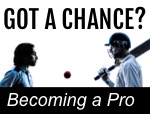|
 One early season challenge is the adaptation from indoor surfaces to slow and two paced grass pitches. One early season challenge is the adaptation from indoor surfaces to slow and two paced grass pitches.
The team I coach learned that the hard way at the weekend and it has promoted significant conversations and work in the subsequent days. It’s been great to see how “failure” and effective self-review has led to excellent and - largely self-generated - practice.
My team lost six wickets on Saturday to lob up catches from full deliveries on a typically “English” slow early season pitch.
So how can coaches help our young charges to control the better the ball better on slow early season decks?
The Sachin Tendulkar bounce-ball game
I had the huge honour of throwing some balls to Sachin Tendulkar back in 2008.
I expected Sachin to ask me to unleash some thunderbolts but instead he asked me to throw some slow half volleys and full tosses so he could practice playing the ball right under his eyes.
The worlds greatest batsmen hit these average balls directly into the ground in front of him using a straight drive.
The ball bounced harmlessly straight back to me and I would catch it in my mitt. The reason why he was doing this was to help him control his contact ahead of the Test match on the notoriously slow Chennai pitch.
This drill can be repeated with tennis balls which means that players of a young age can practice in pairs (buddy-up) and work together.
The Gary Kirsten nugget of gold
The former South Africa and India World Cup winning coach, Gary Kirsten encourages players to
“Hit the ball on the down swing, not the follow through”.
It’s a different coaching cue for the same outcome as the Tendulkar drill above. This will give the player more control and help establish a consistent and appropriate contact point.
The ball will hit the ground early on its journey into and through the infield.
Think about it, how many young players do we see having a lovely finish and follow through to their drive yet they either miss it or they hit it in the air as their follow through also incorporates the contact point?
Stand at the side of the net and watch your batters strike the ball from throw downs or bowling machine and notice if they are hitting on the downswing or on the follow through.
It’s a great coaching point and an easy thing for a player to get their head around.
Subtle & individual differences in contact points
We do know that some players can make contact with the ball slightly further in front of convention and still control the ball perfectly as a result of their body organisation and incredibly high levels of hand to eye coordination.
Kevin Pietersen, Shane Watson, Michael Clarke and Jos Buttler are examples of this. However, all of these players hit their best drives on their downswing.
These types of players may well be compromised by the conventional statement of “hit the ball under your eyes”. They prefer to see the contact in front of their eyes rather than under them.
The “hit the ball on the down swing; not the follow through” is a good tip for them as they will be able to relate to it and execute effectively.
About 25% of the population have this type of body organisation which includes highly attuned hand-eye coordination and the ability to control contact (catching and batting) better slightly further away from them than other players.
Factor this in when observing your players, especially from that sideways on angle.
So there you have it.
Two legends of the game incorporating very simple yet highly relevant coaching methodology into their practice and coaching language in order to overcome the challenges of slower, early season pitches.
If it’s good enough for Gary and Sachin then it’s good enough for the U14 School batters too!
Discuss this article with other subscribers
|

.jpg)



.jpg)

